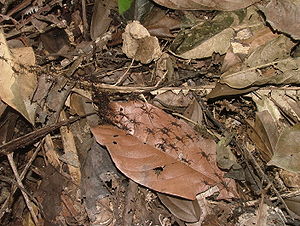The legionnaires are a species of army ants that destroy everything in their vicinity, they eat insects, small mammals, birds... any living creature that gets in their way will eat

Among the arthropods, insects occupy a prominent place, several types of insects have developed forms of social organization that turn society into an essence that acts as one body. The most well-known and famous are the members of the bee family which includes the bees and the types of ants, one of the types of ants known to be "infamous" are the Ponerinae, army ants / robbers / legionnaires.... (hereafter legionnaires).
They are notorious as it is common to see the legionnaires as destroying everything in their surroundings, they eat insects, small mammals, birds... any living creature that comes across will be eaten. The distribution of the genus overlaps with the equatorial regions (and deciduous forests) in Asia, Africa and especially in America where about 300 species associated with Legionaria have been identified.
The ants are organized in huge "tribes" where each tribe has a number of fertile females (queens). The majority of the population as a whole is made up of "workers" whose role varies according to their age, where the young workers take care of the "queen" with eggs and maggots, while the older ones go on "hunting trips" up to a distance of hundreds of meters from the nest, and bring to the nest everything they have hunted in the field.
The area around the nest is divided into a circle where every day the legionaries cover a cone-shaped space, the area of the entire circle is covered in about two weeks, up to twenty days, this is also the time needed for laying, hatching and rolling the maggots into young ants, so that after the breeding cycle is over the legionaries are ready to move to a new place. The queens are carried by "bearers" and the legion sets out, every night a temporary nest is organized that is made of thousands of workers that form a spherical structure with the queens inside.
After marching for several days, the legion arrives at a new "permanent camp" and the circular cycle of raising a new generation while eating everything within the radius of the circle repeats.
The way of life and hunting raids of the Legionnaires is always considered "cruel", as well as offensive to the natural environment. But recently it became clear that there are species of legionnaires that form the basis of a long and winding food chain. It turns out that legionnaires "support" several hundreds of species, starting with tiny acariae, through insects that accompany the "battalions", and up to birds and mammals.
Naturalists Carl and Marian Rettenmeyer from the University of Connecticut in the USA Carl /Marian Rettenmeyer -University of Connecticut, US. Collecting data on the legionnaires, collected over the past fifty years, together and with the help of other biologists, the two built a list of animals observed in the "company" of the legionnaires of the species Eciton burchellii, a species that lives in the forests of South America and is known to send "raiding squads" through tree branches.
The "squads" return to camps that are set up in piles of branches or inside tree trunks, in each colony about half a million workers, as described above, every two weeks a column of legionnaires leaves on a migration for a number of days until the next "breeding" camp.
It turns out that around the legionary activity there are many creatures whose existence depends on the ants, biologists call the "guests" around the legionary activity "associate species", because of the "bad reputation" of the legionary, the researchers concentrated on the damage caused and did not pay attention to the web of life that exists around the legionary groups who are already in -1952 began to collect data on common species were the Rattenmayers.
Carl Rattenmeier died in April 2009. His work was completed by a team of biologists led by Dr. Bergoff who will publish the findings soon. According to the material collected from 345 colonies, 557 species were identified as "partners" to one species of legionnaires, of which 300 species depend on ants for their existence (at different levels), including 29 species of birds that eat the creatures that escape from the ants, 239 species of butterflies were seen hovering and collecting Food around the ant column, parasitic wasps exist around the colony, beetles, aphids, flies, and other scavengers feed on the remains that the legionaries leave in the field.
The researchers say that to these must be added the many species of microorganisms that exist inside the nest, i.e. the legionnaires that "destroy" so many species in raids and migrations, creating a basis and possibility for a great variety of life.

4 תגובות
Answer to the source:
http://www.youtube.com/watch?v=prjhQcqiGQc&feature=player_embedded
In the context of ants: do you know a reason for this phenomenon: http://www.neatorama.com/2010/09/13/ant-death-spiral/
The circle of death of the ants…
I'd love to read
Fascinating and excellent article
Only one species indiscriminately destroys its own kind and by the way (b. the.w.) also its environment!! See atomic tests + Hiroshima and Nagasaki.... "Reason" will be defeated in the face of the viruses!!!!....